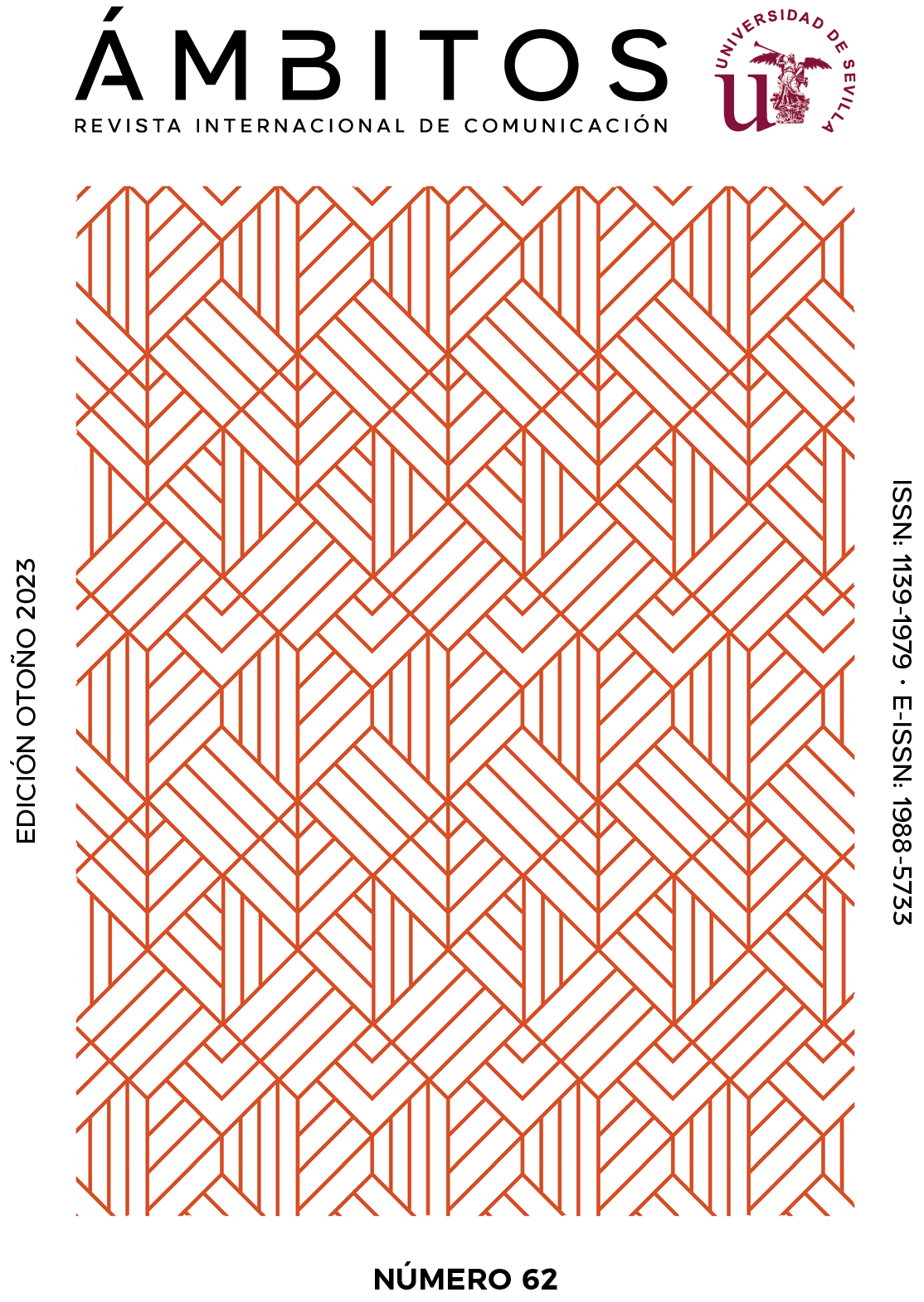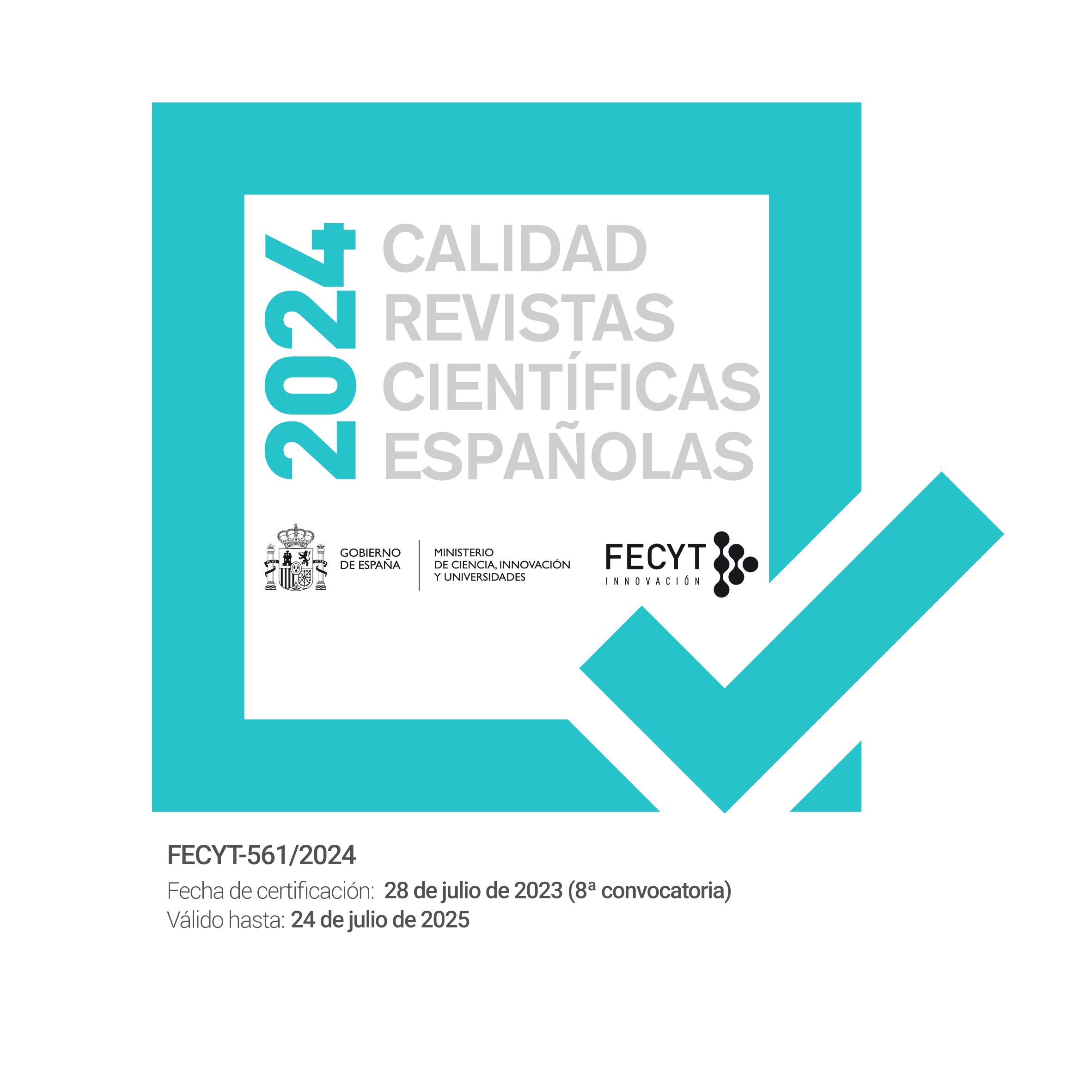Use of Twitter and media coverage of the Andalusian Holy Week due to the suspension of processions caused by Covid-19
DOI:
https://doi.org/10.12795/Ambitos.2023.i62.08Keywords:
Religion, social networks, participation, pandemic, COVID-19Abstract
Easter Week in Andalusia is one of the greatest manifestations of popular religiosity. Citizens have been taking part in traditional processions, acts and events since the 14th century. Covid-19 meant that in 2020 and 2021 these events could not be held in the streets, but the work of the brotherhoods remained active, especially in social networks, which was echoed in the media. This article uses content analysis to investigate the 2,856 tweets published by the institutions that organise the Easter Week processions in the eight provincial capitals of Andalusia between 14/03/2020 and 31/01/2021. In addition, an automatic categorisation was carried out with MeaningCloud and their presence in the media was analysed through MyNews, in order to identify news related to the exhibitions of the religious heritage of the brotherhoods that were announced at Easter in the absence of on-site processions. This last analysis was carried out with publications between 01/01/2021 and 28/02/2021. It was found that the Council of Brotherhoods of Seville was the entity with the most posts, but also the one with the most tweets that were not retweeted by the online community; and that the publication of content was concentrated in April 2020. It is confirmed that the number of publications on Twitter does not imply a greater impact or interaction with the public and that the analysis with automated tools is not adapted to the specific terminology and the presence in the media is not relevant.
Downloads
References
Alonso González, M. (2015). Hermandades de Semana Santa y redes sociales. Las nuevas tecnologías al servicio de la Información Cofrade. Pangea, 6(1), 127-158. https://doi.org/10.52203/pangea.v6i1.117
Bardin, L. (1996). Análisis de contenido (C. Suárez, Trad.). Ed. Akal.
Bon, N. G. (2008). The pilgrimage to Stavridi in the Himarë/Himara area of Southern Albania. Glasnik SED, 48(1-2), 44-54. https://bit.ly/3nuKBqK
Calvo Rubio, L. M., Cantero de Julián, J. I., & Serrano Tellería, A. (2019). La comunicación transmedia en las celebraciones populares. El caso de la Semana Santa en Cuenca. Sphera Publica: Revista de Ciencias Sociales y de la Comunicación, 1(19), 91-110. https://bit.ly/2QjAaLN
Carreras Álvarez, M. del V. (2012). La implantación de las redes sociales en el mundo cofrade. El caso de las hermandades de penitencia de Sevilla. En K. M. Ayerdi & A. L. Urreta (Eds.), IV Congreso Internacional de Ciberperiodismo y web 2.0 (pp. 1-17). Servicio Editorial de la Universidad del País Vasco. http://hdl.handle.net/10810/41327
Cartes Barroso, M. J. (2016). Perfil, formación y horizontes del informador cofrade. En M. Saavedra Llamas & M. de Miguel Zamora (Coords.) & C. Jiménez Narros (Ed.), Tendencias en el ecosistema mediático (pp. 39-49). Dykinson. https://www.torrossa.com/en/resources/an/4145976
Cartes Barroso, M. J. (2019). Análisis de la presencia de las hermandades rocieras en las redes sociales. Question/Cuestión, 1(63), e181. https://doi.org/10.24215/16696581e181
Chen, S., Law, R., Xu, S., & Zhang, M. (2020). Bibliometric and Visualized Analysis of Mobile Technology in Tourism. Sustainability, 12(19), 7975. https://doi.org/10.3390/su12197975
Cristófol Rodríguez, C., Cristòfol, F. J., & Paniagua Rojano, F. J. (2014). Religion through the local media on Twitter. The Holy Week in Malaga. Trípodos, (35), 43-55. https://bit.ly/3dK4wzD
De Ascaniis, S., Mutangala, M. M., & Cantoni, L. (2018). ICTs in the tourism experience at religious heritage sites: A review of the literature and an investigation of pilgrims’ experiences at the Sanctuary of Loreto (Italy). Church, Communication and Culture, 3(3), 310-334. https://doi.org/10.1080/23753234.2018.1544835
De Carvalho, L. F., Carazza, E. A., Carvalho, D. B. F., Corrêa, F., & Brasileiro, A. D. F. (2016). (2016). Development of e-guide app for the Holy Week. En SBSI 2016 - 12th Brazilian Symposium on Information Systems: Information Systems in the Cloud Computing Era (Vol. 1, pp. 361-368). https://bit.ly/3sMylnN
de Sousa, M., & da Rosa, A. (2020). The Mediatization of Camino De Santiago: Between the Pilgrimage Narrative and Media Circulation of the Narrative. Religions, 11(10), 480. https://doi.org/10.3390/rel11100480
Dragić, M. (2019). The Feast of Corpus Christi in Croatian Catholic Church-folk cultural heritage. Crkva U Svijetu, 54(1), 59-81. https://bit.ly/3nslRiM
El-Gohary, H. (2020). Coronavirus and Halal Tourism and Hospitality Industry: Is It a Journey to the Unknown? Sustainability, 12(21), 9260. https://doi.org/10.3390/su12219260
Ferencová, M., Mišenčíková, V., & Kot, S. (2014). An analytical view of using e-communication tools in promoting of selected pilgrim tourism sites in Slovak Republic. Journal of Environmental Management and Tourism, 5(2), 223-229.
Fernández Rodríguez, M. L. (2016). Discursos sobre Santiago de Compostela y el/los caminos de Santiago en la novela española actual (2010) a través de nuevas técnicas analíticas digitales: Posibilidades y valor de conocimiento generado [Tesis doctoral, Universidad de Santiago de Compostela]. Minerva, Repositorio Institucional da USC. https://minerva.usc.es/xmlui/handle/10347/14936
Fuentetaja, I. G., & Abad-Galzacorta, M. (2019). Religious tourism and emotional experiences: An emotional cartography of Jerusalem. International Journal of Religious Tourism and Pilgrimage, 7(2), 105-121. https://doi.org/10.21427/rw1f-9087
Gilli, M., & Palmisano, S. (2016). Holy holidays: Why is monastic tourism attractive? Insight from Italian Catholic Monasticism. En I. Jonveaux & S. Palmisano (Eds.), Monasticism in modern times (pp. 99–115). Routledge. https://doi.org/10.4324/9781315595986
Jansen, W., & Notermans, C. (Eds.). (2012). Gender, nation and religion in European Pilgrimage. Routledge., 10.4324/9781315584126
Jupowicz-Ginalska, A., Leonowicz-Bukała, I., & Adamski, A. (2020). Polish Nationwide Catholic Opinion-Forming Weeklies on Facebook—A Marketing Perspective. Religions, 11(5), 246. https://doi.org/10.3390/rel11050246
Khabibullina, Z. R. (2019). Taking selfies in mecca: Haram or still the venerable Hajj? Siberian Historical Research, (2), 85-107. https://doi.org/10.17223/2312461X/24/5
Kim, H., Yilmaz, S., & Ahn, S. (2019). Motivational landscape and evolving identity of a route-based religious tourism space: A case of camino de santiago. Sustainability, 11(13). https://doi.org/10.3390/su11133547
Krihtova, T. (2018). Easter cakes on Instagram. Spectalisation of Easter by young russian women. Tikhon University Review, 79(79), 98–114. https://doi.org/10.15382/sturI201879.98-114
Kurrat, C., & Heiser, P. (2020). ‘This trip is very meaningful to me, so I want to remember it forever’: Pilgrim tattoos in Santiago de Compostela. International Journal of Religious Tourism and Pilgrimage, 8(5), 12–24. https://bit.ly/2RUZojL
Lane, D. (2019). ‘Know thyself and change the world’: The Western Pilgrimage narrative and South Asia. International Journal of Religious Tourism and Pilgrimage, 7(2), 76-84. https://bit.ly/3vk1qIT
Marine-Roig, E. (2019). Destination Image Analytics Through Traveller-Generated Content. Sustainability, 11(12), 3392. https://doi.org/10.3390/su11123392
Moscarelli, R. (2020). Il turismo lento come occasione di pianificazione territoriale e di rinnovamento urbano: il caso del cammino di Santiago. Archivio di studi urbani e regionali, 129(3), 152-174. https://doi.org/10.3280/asur2020-129007
Muaremi, A., Bexheti, A., Gravenhorst, F., Seiter, J., Feese, S., Arnrich, B., & Tröster, G. (2014). Understanding aspects of pilgrimage using social networks derived from smartphones. Pervasive and Mobile Computing, 15, 166-180. https://doi.org/10.1016/j.pmcj.2014.06.006
MyNews. (2021). Hemeroteca Digital. https://www.mynews.es/hemeroteca-digital/
Parish, H. (2020). The absence of presence and the presence of absence: Social distancing, sacraments, and the virtual religious community during the covid-19 pandemic. Religions, 11(6), 276. https://doi.org/10.3390/rel11060276
Park, H., Seo, S., & Kandampully, J. (2016). Why post on social networking sites (SNS)? examining motives for visiting and sharing pilgrimage experiences on SNS. Journal of Vacation Marketing, 22(4), 307-319. https://doi.org/10.1177/1356766715615912
Park, J., Bonn, M., & Cho, M. (2020). Sustainable and Religion Food Consumer Segmentation: Focusing on Korean Temple Food Restaurants. Sustainability, 12(7), 3035. https://doi.org/10.3390/su12073035
Popelková, K. (2019). Easter and the ways of celebrating it in slovakia in the 21st century. Narodopisna Revue, 29(4), 275-286. https://bit.ly/46xQz0t
Qurashi, J., & Sharpley, R. (2018). The impact of SMART media technologies (SMT) on the spiritual experience of hajj pilgrims. International Journal of Religious Tourism and Pilgrimage, 6(3), 37-48. https://bit.ly/48NRFHs
Ramos, C. M. Q., Henriques, C. H. N., & Lanquar, R. (2016). Augmented reality for smart tourism in religious heritage itineraries: Tourism experiences in the technological age. En J. Rodrigues, P. Cardoso, J. Monteiro, & M. Figueiredo (Eds.), Handbook of research on human-computer interfaces, developments, and applications (pp. 245-272). IGI Global. https://doi.org/10.4018/978-1-5225-0435-1.ch010
Robina Ramírez, R., & Pulido Fernández, M. (2018). Religious Experiences of Travellers Visiting the Royal Monastery of Santa María de Guadalupe (Spain). Sustainability, 10(6), 1890. https://doi.org/10.3390/su10061890
Rodríguez-Fernández, M. M., Rodríguez-Vázquez, C., & Martínez-Fernández, V. (2015). Social media communication and the Way of Santiago. 10th Iberian Conference on Information Systems and Technologies (CISTI) (pp. 1-16). IEEE. https://doi.org/10.1109/CISTI.2015.7170580
Štefko, R., & Mudrík, M. (2017). Using social networks to create and share experiences in creative tourism. En A. Kiráľová (Ed.), Driving tourism through creative destinations and activities (pp. 260-277). IGI Global. https://doi.org/10.4018/978-1-5225-2016-0.ch013
Tinto Arandes, J. A. (2013). El análisis de contenido como herramienta de utilidad para la realización de una investigación descriptiva. Un ejemplo de aplicación práctica utilizado para conocer las investigaciones realizadas sobre la imagen de marca de España y el efecto país de origen. Provincia, (29), 135-173. https://bit.ly/2QONvf2
Vekemans, T. (2019). Roots, Routes, and Routers: Social and Digital Dynamics in the Jain Diaspora. Religions, 10(4), 252. https://doi.org/10.3390/rel10040252
Venugopal, K., & Vishnu Murty, D. (2019). Impact of e-marketing promotions on the performance of religious tourism: In case of srikakulam district, A.P, India. International Journal of Engineering and Advanced Technology, 8(6s3), 1289-1292. https://doi.org/10.35940/ijeat.F1223.0986S319
Wiśniewski, L. (2018). Religious tourism in christian sanctuaries: The implications of mixed interests for the communication of the faith. Church. Communication and Culture, 3(3), 199-220. https://doi.org/10.1080/23753234.2018.1537674
Downloads
Published
How to Cite
Issue
Section
License
Copyright (c) 2023 F. J. Cristòfol, Jesús Segarra-Saavedra, Carmen Cristófol-Rodríguez

This work is licensed under a Creative Commons Attribution-NonCommercial-ShareAlike 4.0 International License.
Ámbitos. Revista Internacional de Comunicación is an open access journal, which means that all content is freely available at no charge to the user or their institution. Users may read, download, copy, distribute, distribute, print, search or link to the full text of articles, or use them for any other lawful purpose, without seeking prior permission from the publisher or author. This definition of open access is in accordance with the Budapest Open Access Initiative (BOAI).

Unless otherwise noted, all content in the electronic edition is distributed under a "Creative Commons Attribution-NonCommercial-ShareAlike 4.0 International License". You can consult the informative version and legal text of the licence here. This should be expressly stated in this way where necessary.
In case of acceptance of the manuscript, the authors cede the rights of the work for its publication to Ámbitos. Revista Internacional de Comunicación under the Attribution-NonCommercial-ShareAlike 4.0 International license contract (CC BY-NC-SA 4.0). The authors retain copyright and third parties are authorised to copy, distribute and make use of the work, provided they comply with the terms and conditions set out in the licence
- Cite the authorship and the original source of publication (journal, publisher and URL of the work).
- Do not use them for commercial purposes.
- If you remix, transform or create from the material, you must release your contributions under the same license as the original.
More information can be found at https://creativecommons.org/licenses/by-nc-sa/4.0/deed.es


















